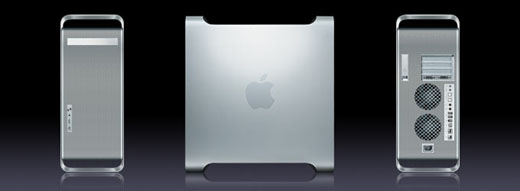No more mysteries: Apple's G5 versus x86, Mac OS X versus Linux
by Johan De Gelas on June 3, 2005 7:48 AM EST- Posted in
- Mac
Introduction
It is a professional 64 bit Dream machine with supersonic speed! It is beautiful. It is about the ultimate user friendliness. It is about a lifestyle. It is a class apart. You guessed it - I am parroting Apple’s marketing.For some reason, the performance of Apple’s gorgeous machines has been wrapped in a shroud of mystery. Yes, you could find a benchmark here and there, with one benchmark showing that the PowerMac is just a mediocre PC while another shows it off as a supercomputer, the unchallenged king of the personal computer world.

If you like a less performance-obsessed article about Apple, OS X and the G5, you should definitely give Anand’s articles in the Mac section on AnandTech a read...
In this article, you will find a pedal to the metal comparison of the latest Xeon DP 3.6 GHz (Irwindale), Opteron 250, Dual G5 2.5 GHz and Dual G5 2.7 GHz.
Scope and focus
Apple’s PowerMac is an alternative to the x86 PC, but we didn’t bother testing it as a gaming machine. Firstly, you have to pay a big premium to get a fast video card – as a standard, you get the ATI Radeon 9650 - even on the high-end PowerMacs. Secondly, there are fewer games available on this platform than on the x86 PC. Thirdly, hardcore gamers are not the ones buying Apples, but rather, creative professionals.So, we focus on workstation and server applications, especially the open source ones ( MySQL, Apache) as Apple is touting heavily on how important their move to an “open source foundation” is.
The 64 bit Apple Machines were running OS X Server 10.3 (Panther) and OS X Server 10.4.1 (Tiger), while our x86 machines were also running a 64 bit server version of a popular Open Source Operating Unix system: SUSE Linux SLES 9 (kernel 2.6.5). We also included an older Xeon 3.06 GHz ( Galatin, 1 MB L3) running SUSE SLES 8 (kernel 2.4.19) just for reference purposes. Some of the workstation tests were done on Windows XP SP2.










116 Comments
View All Comments
wessonality - Friday, June 3, 2005 - link
ailleur2 - Friday, June 3, 2005 - link
Oh and the graph on page 5 doesnt display correctly in firefox.ailleur2 - Friday, June 3, 2005 - link
Well that was interesting.Im a big apple fan myself but even i never thought od putting osx server in a server room.
I think the g5 did quite well and had IBM delivered its promise of a 3ghz g5 (and that was supposed to be a year ago) the g5 would have won a couple of tests by a good margin.
If apple/IBM want altivec optimisations, i think theyll have to do it themselves since the interest level is pretty low.
One question though, why wasnt linux installed of the g5 if this was a cpu test? I dont know if it makes a damn of a difference but it whould have put them on equal bases.
Methodical - Friday, June 3, 2005 - link
I like anands articles way better.Your drawing too many conclusions off of data you basically call untrustworthy, but I agree your basic conclusion. The OS still needs more work.
I really think leaving out After Effects was a bad idea. Its a perfect benchmark. Plugins that do the exact same calculations on the exact same workfiles. Its also one of the biggest things these macs are used for, but I understand your article to be a bit more server-oriented.
Bahlo - Monday, December 13, 2021 - link
Actually, for better or worse the GCC Apple includes is being used for most Mac OS X software. OS X itself was compiled with it. https://setbitv.com/Bahlo - Thursday, May 5, 2022 - link
jhagman, the number in the apache test table means the request per second that the server handles.https://setbitv.com/abonnement-iptv1/